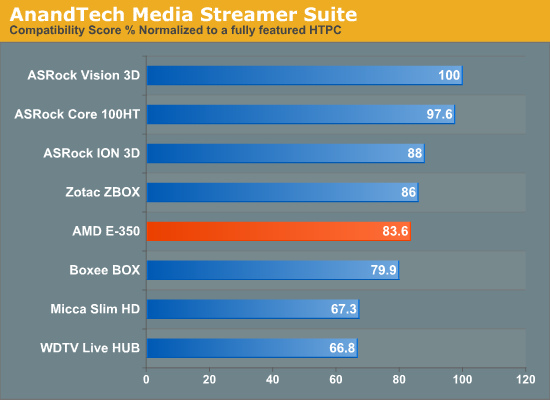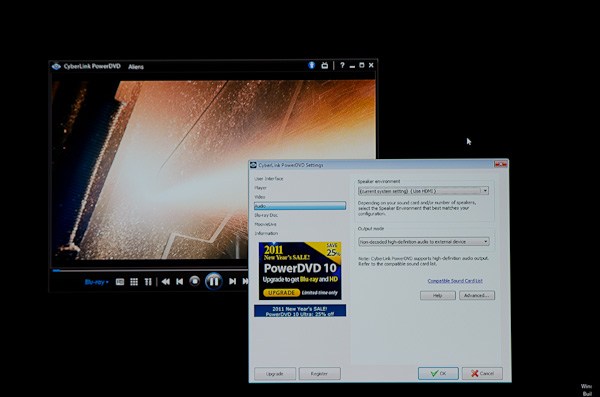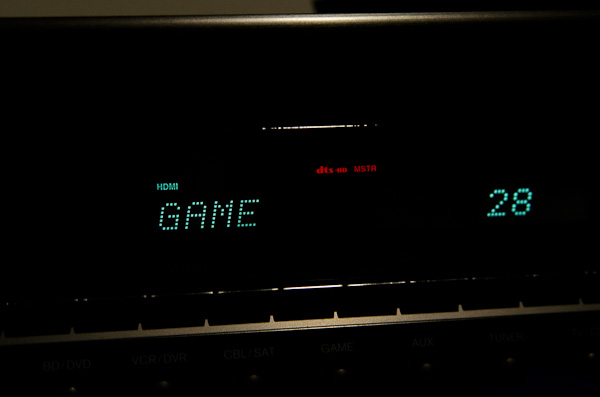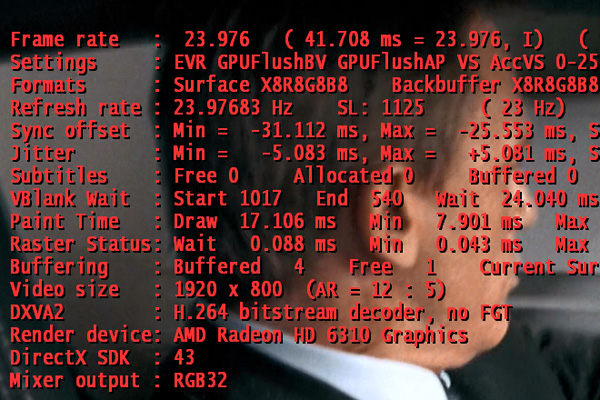The Brazos Review: AMD's E-350 Supplants ION for mini-ITX
by Anand Lal Shimpi on January 27, 2011 6:08 PM ESTVideo Decode Capabilities: Is Brazos the New ION?
While Atom may have been the right product at the right time, it was a very conservative architecture paired with a very conservative platform. For netbooks and nettops Intel chose to assume no risk at all, pairing Atom with the proven 945 chipset. As a result, it left a lot of room for innovation - something NVIDIA saw and capitalized on with ION.
While VIA created the mini-ITX form factor, it was really NVIDIA that made it interesting. The first mini-ITX ION platforms gave you almost everything you needed to build a fully capable HTPC. For video playback, with NVIDIA’s GPU (or at least its fixed function decode pipeline) doing the heavy lifting, the fact that you had an anemic Atom a couple centimeters away didn’t matter. The problem with ION is that it had no future. Without a DMI license, NVIDIA would not be able to build future versions of ION for Atom’s successors. Even after the settlement it’s unlikely we will ever see modern versions of ION, especially considering that Intel’s 2011 Atom platform (Cedar Trail) will finally integrate H.264 decode acceleration in Q4.
Where Intel is conservative, AMD will innovate. Brazos adds a number of advantages from a media standpoint over Atom. There’s native HDMI support and a full implementation of AMD’s UVD3 decode engine supporting hardware H.264, VC-1 and MPEG-2 acceleration. Although both of these advantages are also enjoyed by ION the next feature isn’t. Brazos supports Dolby TrueHD and DTS-HD MA bitstreaming over HDMI. From a feature standpoint, Brazos is even more complete than ION.
I ran MSI’s Brazos board through our Media Streaming compatibility suite. Below is Brazos’ compatibility score compared to the other devices and HTPCs we’ve put through the suite:

Failed Tests
- 1080p60 60 fps L5.1 H.264
- L5.1 H.264 (16 reference frames)
- FLAC, ASS Subs - High CPU Utilization
- HD Real Media
- Deinterlacing
Numerically, Brazos actually falls behind ION. Allow me to explain why. Our Media Streaming suite tests virtually everything you might throw at a HTPC. When it comes to the most commonly found content, Brazos excels. It can handle Blu-ray discs (although there’s no Blu-ray 3D support), it can deal with 1080p x264s commonly found online and it even accelerates Flash video (more on this later). Brazos’ UVD3 however is tied to clock speed, and the GPU clock of the Radeon HD 6310 is pretty low at 500MHz. As a result, Brazos fails certain tests. The platform is incapable of accelerating and playing back 1080p60 H.264 video. Very little content falls into this category, however if you want to play it you can’t on Brazos. The good news is 1080i60 works just fine.
Brazos’ GPU also fails all of our deinterlacing tests, something we noticed in reviews of AMD’s entry level GPUs. The higher end models don’t have an issue here but the lesser equipped models do. Again, chances are that you won’t want to watch interlaced content on your Brazos HTPC so this is likely not a big issue.
The other shortcomings are videos with components that aren’t accelerated by UVD3. For example, HD Real Video chugs on Brazos as does our heavy FLAC + ASS subs test. If you’re playing non-3D Blu-ray content or 1080p24 x264s you find on the web, Brazos will easily fit the bill. It’s the more eccentric content that you’ll run into CPU limitations with.
Since the Radeon HD 6310 is derived from AMD’s desktop GPUs we get full 23.976 fps support when you select 23Hz in AMD’s Catalyst driver:
Selecting 24Hz yields a 24.000Hz refresh rate.
As I mentioned earlier bitstreaming both TrueHD and DTS-HD MA are supported over HDMI:














176 Comments
View All Comments
tno - Thursday, January 27, 2011 - link
http://www.anandtech.com/show/4017/vias-dual-core-...Not a full review but darn close.
e36Jeff - Thursday, January 27, 2011 - link
they did, its here:http://www.anandtech.com/show/4017/vias-dual-core-...
Problem is that what they tested was basically an engineering sample built on the wrong node, they havent gotten anything to market yet, so actual numbers from real products are unknown. having said that, yeah it does look like it might be better, but until someone makes a product based on it, we'll never know.
nitrousoxide - Thursday, January 27, 2011 - link
The price itself is stopping Nano X2 from dominating APU or Atom in the compete. The Nano platform consists of 3 different chips (aka CPU, NB, SB as the traditional layout) but the latter two managed to do that with only one chip, especially APU with very small die size. While Nano X2 is an impressive part compared to APU and Atom in absolute performance, it's not competitive in other features such as die size, price and power consumption.Tralalak - Friday, January 28, 2011 - link
AMD Zacate TDP Configs@18W + Hudson M1 = Fusion Controller Hub = ("South Bridge") TDP Configs@2,7W to 4,7 W for typical configurations === AMD Brazos 20,7W to 22,7W TDP. (2 chip solution)VIA say: VIA Nano X2 have some TDP than VIA Nano Single-Core.
VIA Nano X2 1.4GHz (40nm TSMC) have some TDP than VIA Nano U3200 1.4GHz (65nm Fujitsu) TDP = 6.5W
VIA Nano X2 1.4GHz max. TDP@6.5W + all-in-one chipset VIA VX900 MSP (Media System Processor = North Bridge (IGP) + South Bridge) max. TDP@4,5W === max.TDP@11W (2 chip solution)
I mean that In "minibotebook market" is very competitive.
VIA's 40nm next all-in-one chipset VIA VX MSP with DirectX 11 IGP refresh will appear in Q4 2011.
mczak - Monday, January 31, 2011 - link
VX900 has Chrome9 HC3 graphics core at 250Mhz - the same as VX800. Its 3d performance can barely keep up with the atoms anemic IGP (I could not find ANY review of VX900, just VX800), so totally no match for Brazos (though, in contrast to atom, it should support video decode much better). So your TDP comparison basically ignores the 3d part of it (surely the graphics core won't consume that much given its performance).Alright, even if I were to believe the DC Nano has same TDP as the current single core one, traditionally perf/power has never been that good with those VIA chips (not terrible, just not really good). Maybe their TDP definition is different (btw I've never seen a published TDP figure for any of the nano u3xxx series, which you seem to use as reference), also keep in mind runtime of notebooks is barely affected by TDP, much more important if you can get low idle power figures. I have no idea how the VIA platform would compete there (granted the publish idle power of the nano u3xxx cpus is only 100mW), but based on past designs I have to assume not very well (fwiw, this article here doesn't help for that neither, since the atoms don't have all of their mobile siblings power management features enabled).
So, unless VIA delivers, I remain sceptical if they can be competitive. Yes, a 1.4Ghz Nano DC should be quite competitive with 1.6Ghz Zacate performance wise - maybe also power wise, but 3d graphics will be very very sub par. To catch up in that area the new IGP is needed which as you mentioned is q4 (if the graphic core is like VN1000, it should do quite well, though I'll note that VN1000 plus the required southbridge has a 12W TDP).
bjacobson - Saturday, January 29, 2011 - link
I for one will be clicking any links with more info on these nanos! That sorely beat the Brazos out of nowhere hah!I doubt the it'll be much good at games though, and the drivers will be rough.,,
silverblue - Monday, January 31, 2011 - link
I've seen the Nano in comparison with Brazos before so I knew it was capable of being faster, however it'll take a load more power.The last time I saw a proper Nano rundown, we were talking a 65nm chip...
Iketh - Thursday, January 27, 2011 - link
power consumption is considerably higher on NanoAmdInside - Thursday, January 27, 2011 - link
Just curious if it was a fad or are people still buying Atom systems? I bought an Atom netbook but sold it within 30 days cause I couldn't stand it (Dell Mini 10v). Then I bought an ION Zotac Atom 330 system to use as a video streaming device for my bedroom and while I do like it for what it does, I just can't see myself buying another cheap lower powered Atom/AMD E-350 like device. I bought mine because the price made it seem like a great deal but once I got past that, I just lost interest in netbook/low powered mini-ITX platforms. Tablets on the other hand I am still hooked on. Love my iPad and may pick up a second this year and pass mine onto my wife.nitrousoxide - Thursday, January 27, 2011 - link
What APU/Atom can do is still far beyond ARM-based tablet's reach. Just look at how much superiority x86 have in absolute performance. E-350 has roughly 5 times the performance of Tegra 2, and even an Atom is significantly faster. So tablet is just an alternative of nettops, not a replacement. If you are fine with you iPad that's cool, but saying that nettop is dead is still far too early.The superiority of x86 is just unmatched by ARM, and that's why Intel claims that ARM is not a big deal for it. Want to be as fast? Then add more instructions sets, design more complicated architectures, and what you get is no longer an ARM.